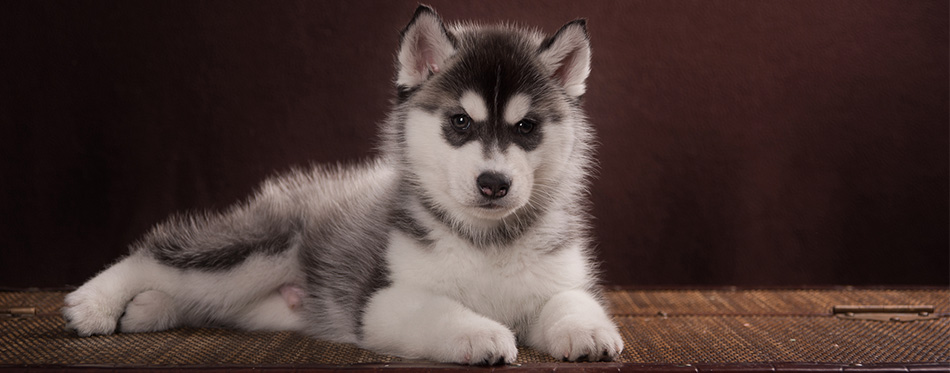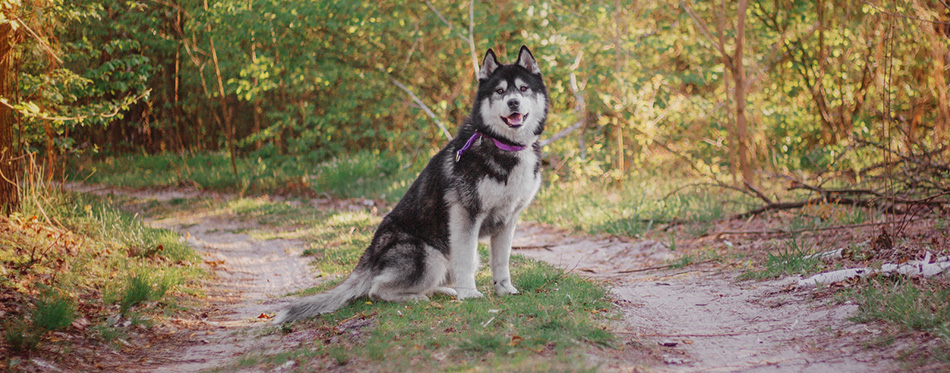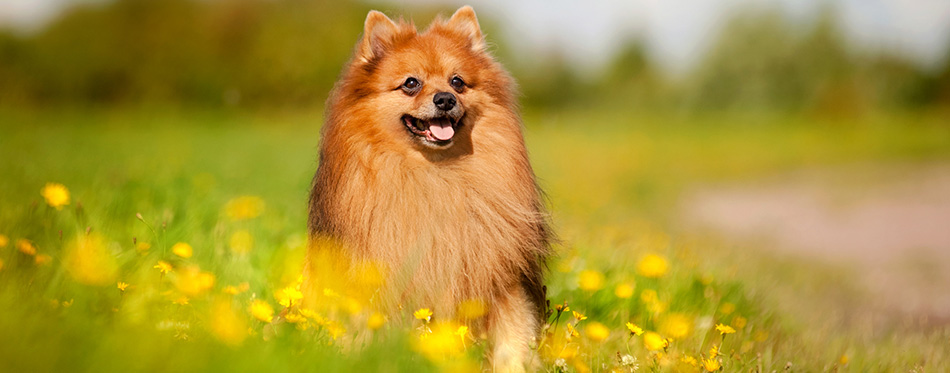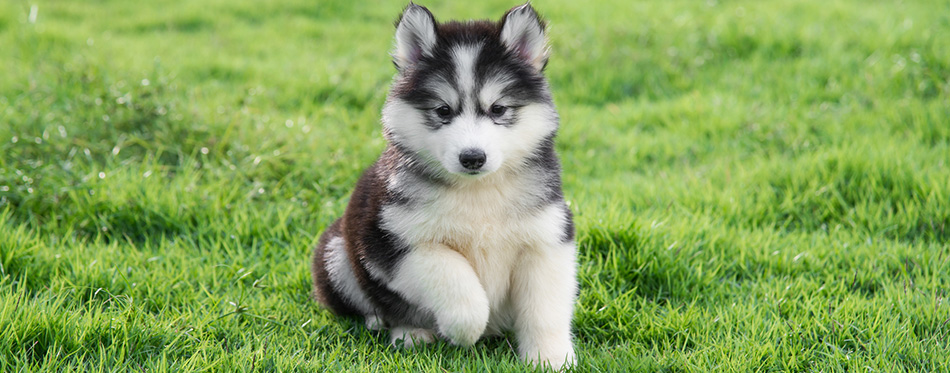It is not surprising if you would also want to bring home a designer hybrid like the Pomsky. It combines the Siberian Husky’s friendly and outgoing nature with the Pomeranian’s sociable, playful, and extroverted personality. However, before you get one, make sure you equip yourself with the correct knowledge about this particular hybrid dog. You may think that it combines the best of both Pomeranian and Siberian Husky worlds. The fact of the matter is that it is very difficult to establish with absolute certainty how such a pairing will turn out in the real world. Let this article be your guide to help you decide whether the Siberian Husky Pomeranian Mix is the right dog for you.

History of the Pomsky
In 2011, the internet was abuzz with cute pictures of adorable puppies that people said were a mix of Siberian Husky and Pomeranian. This was in a February 3 post on BuzzFeed. Some commented that the pictures posted were those of a Finnish Lapphund puppy. There were also others who raised the issue of crossing a small dog (Pomeranian) with a larger dog (Siberian Husky). No one can tell for sure whether the pictures on that feed was indeed a Pomsky. What is certain, however, is that it generated widespread interest in the hybrid dog.
Because of this sudden interest in the Pomsky, some folks in the US started turning the myth into a reality. However, there is one basic problem. The tallest Pomeranian stands only 11 inches while the smallest Siberian Husky was 19 inches. There is still an 8-inch height advantage for the Siberian Husky. This means it is physically impossible for these two purebreds to mate in a natural manner.
Hence, the only way designer dog breeders could realize the creation of a Pomsky is through artificial insemination. This makes the Pomsky quite controversial. Since it is not a product of natural processes, some consider the Pomsky to be man-made. In fairness, however, the canine parents produced the Pomsky puppies. But, this is only possible because of the “assistance” of man.
The efforts of these designer dog breeders finally paid off in 2012 with the creation of the very first Siberian Husky Pomeranian Mix.
It is important to note that the Pomsky comes from two different purebred dogs – the Pomeranian and the Siberian Husky. What you should also realize is that both of these purebreds come from the same general classification of dogs known as Spitz. Hence, they may be two distinct dog breeds but they sure share some common genes.
In 2014, Pomsky fanciers decided to establish the Pomsky Club of America. The group aimed to strengthen the physical and behavioral characteristics of the Pomsky as critical steps towards recognition as a purebred.
Who Are The Parents?
A true Pomsky hybrid is a combination of 50% Pomeranian and 50% Siberian Husky. Hence, understanding a bit more about these individual parent purebreds will lead to a better understanding of the Pomsky.
Siberian Husky
If you’ve seen “Eight Below” or “Balto”, then you are already familiar with the Siberian Husky. They may be smaller than the Alaskan Malamute, but Huskies are bred for speed and endurance over harsh snowy terrains. They are famous for bringing hope to the beleaguered town of Nome, Alaska. Crossing more than 600 miles of the treacherous Alaskan landscape, teams of Siberian Husky-pulled sledges brought anti-diphtheria vaccines to the disease-stricken town in 1925.
These dogs are escape artists, often chewing through fences or digging under them. If the fence is low enough, the Husky can jump over it. Huskies have a very playful nature, making them natural nannies and playmates for children. They have a strong prey drive, however, which makes them quite dangerous to small pets.
Siberian Huskies are a resilient breed. They are energetic and active and love the company of their family. They can grow up to 24 inches and weigh up to 65 pounds.

Pomeranian
The very first Pomeranians were not this small. They were large working dogs that belonged to the Wolfspitzes of Europe. However, Wolfspitz fanciers in Pomerania decided to create a miniature version of the working dog. By then, these dogs are already called Pomeranians in deference to the region that created them.
The exact process of miniaturization remains unclear, however. What is clear is that the very first mini Wolfspitz ever to cross the English Channel happened in 1767. It was Queen Charlotte who first introduced the breed as a companion dog for the royalty. In 1888, Queen Victoria established a kennel for the breeding of Pomeranians and other dog breeds. However, because of the increasing popularity of Poms, she decided to make the dog even smaller.
Pomeranians today tip the scale at a maximum of 7.7 lbs and can grow as tall as 11 inches. They remain one of the most adorable toy dogs on the planet. Poms are known for their affectionate yet very playful nature. They may be small, but their confidence is huge. They are nimble, always happy, and very clever, too.
Take a look at our review of Dog Food For Pomeranians for more options

Quick Facts
Because Pomskies are quite new in the dog-loving world, there are still a lot of things we do not know about this hybrid dog. What we do know are the following facts:
- A Siberian Husky Pomeranian Mix is also called a Pomsky, a Pomeranian Husky, or a Huskeranian.
- They can achieve heights of up to 15 inches; although it is possible that they can grow taller.
- If the Pomeranian’s genes are stronger in the Pomsky, you can expect its weight to be around the vicinity of 10 pounds. If it is the Siberian Husky’s genes that are more dominant, then you can have a hybrid dog that can weigh up to 35 pounds.
- Since the Pomsky is a very recent “design”, there is no way to determine its actual lifespan. Taking the average lifespans of its parents, however, will show that the Pomsky can live anywhere between 12 and 15 years.
- They make great pets for apartment dwellers.
- Huskeranians are prone to separation anxiety.
- These hybrid dogs are moderate to heavy shedders.
- They are intelligent but may be very stubborn to train.
- They vocalize a lot and have a strong prey drive.
- Pomskies have high energy levels, requiring exercise every day.
Things You Should Know
Owning a Siberian Husky Pomeranian Mix is never easy. One has to understand that we know very little about these designer dogs. Unlike purebreds with definitive characteristics, it is quite difficult to paint how a hybrid will turn out. Nevertheless, there will always be some things that all dogs need regardless of whether they are pure or hybrid.
Training
Canine intelligence is an important parameter when it comes to canine training. However, one has to understand that a dog’s intelligence means nothing if its owner does not know how to cultivate it. For instance, we know that the Siberian Husky is an intelligent dog. We also know that it can be very stubborn to train.
This is one characteristic of smart dogs. They get bored in an instant. They hate repetition. They also dislike very simple tasks. That is why the most intelligent dog breed on the planet only responds to a person who knows how to handle such level of canine intelligence.
Applying this to the Pomsky, we know that it is a mixture of Pomeranian and Siberian Husky. The only problem is that we don’t know from which parent it will get its intelligence. Will it be the Pom with average intelligence? Or will it be the smart yet stubborn Husky?
If the Pomeranian has greater influence on the Pomsky, then you can expect the hybrid to look at training as nothing more than structured play. It may not take things in a more serious manner. On the other hand, if the Siberian Husky has more influence on the hybrid, then you can expect a more stubborn designer dog to train. Do you have the patience to train a stubborn dog that thinks it is smarter than you?
Regardless of which purebred parent has greater influence on the Pomsky’s trainability, it does respond well to techniques that adhere to a reward-based system.
Feeding
It doesn’t matter if your dog is a purebred or not. When it comes to nutrition, only high-quality dog food matters. As for the Pomsky, everything depends on how you intend to raise the hybrid dog. There are some pet parents who turn their dogs into canine couch potatoes that don’t exercise or do much. If such is the case, then it is imperative that you watch the amount of food that you give to the Pomsky. Otherwise, you are courting obesity for your pet.
If the Siberian Husky Pomeranian Mix is able to lead its life as an active dog, then giving it high-calorie, high-protein dog food is essential. When considering the dog’s calorie intake, it is better to compute for its Daily Energy Requirements instead of relying on what the food manufacturer recommends.
When it comes to the best dog food for a Huskeranian, raw whole prey animals are best. But since it is challenging to source this kind of food, the next best thing will be to offer premium-quality raw meats. Add fresh vegetables and fruits to help supply the Pomsky with additional nutrients and antioxidants. If neither of these dog food choices is available, then go for a dog food that is specific for either a Siberian Husky or a Pomeranian. If none is available still, then your last resort should be dog food for small breeds.
For more guides on choosing the right dog food, you may wish to check out our reviews of the best organic dog food, puppy food, dog food for shedding, wet dog food, food for diabetic dogs and vegan dog treats.
Make sure the protein content of such dog food is greater than 30 percent by dry matter weight. The fat content should also not be higher than 20 percent. Be mindful of the other ingredients that may be present in commercial dog foods.
Grooming
Pomskies come from Spitz type dogs that are known for their dense double coats. Hence, be ready with your slicker brush, dog comb, deshedding brush, and other dog grooming tools. Huskeranians expect their pet parents to brush their coats every single day. This is to prevent the formation of tangles, which can worsen and turn into nasty mats.
For more help on dog grooming, you may wish to read our guides on the best dog dryers, medicated dog shampoos, dog ear cleaners, dog paw washers and dog wipes.
Huskeranians are notorious for shedding. They may not be as heavy shedders as German Shepherds, but they can pose serious health risks to people with certain forms of allergies. As such, the Pomsky is a big no-no if you or any other individual in your household happens to have pet dander allergies.
Bathing the Huskeranian should not be too frequent. Once every two weeks is often enough. Once a month bathing is ideal if the hybrid dog doesn’t get dirty that much. Very frequent bathing can remove the natural oils on the dog’s skin. This exposes the Pomsky to skin irritation and possible skin infections.
Trimming its nails is also critical since extra-long nails can be uncomfortable for the Pomsky as it walks or runs. Clip the nails at least once every 2-3 weeks. Do not forget to inspect and clean the Pomsky’s ears. Dust and earwax can accumulate in the ear canal and become a breeding ground for fungi and bacteria. Inspect and clean its ears every week. As for its teeth, you should strive to brush it every day. If it is not possible, then at least try caring for its teeth once every 2 to 3 days. Giving dog dental chews in between also helps. Find out more about dog nail grinders here.
Health
One of the so-called advantages of hybrid dogs is that they are “healthier”. This is because of the belief that they only get a fraction of the risk of developing a certain disease from a purebred parent. However, this does not mean they will never get sick.
To give you an idea, Pomeranians are not that “healthy” in terms of the number of canine diseases that affect the breed. They are prone to collapsing trachea, Legg-Carve-Perthes disease, patellar luxation, genetic alopecia, progressive retinal atrophy, patent ductus arteriosus, cataract, thyroid disease, elephant skin, and growth hormone abnormalities, among others. On the Siberian Husky’s side, hip dysplasia and eye problems are major concerns.
If the Pomsky draws more of its “health” genes from the Siberian Husky, then you can expect eye and joint problems to be more pronounced. But if the Pomeranian’s genes are stronger in the Pomsky, then you can expect more health problems down the line.
The point is that it is almost impossible to get a very accurate prediction of what disease will crop out in the future. The only thing you can do is to prepare for any eventuality.

Temperament
The Siberian Husky Pomeranian Mix is a sweet hybrid dog. It has a wicked sense of humor and a strong tendency to be vocal. When it comes to their vocalizations, the Pomsky produces a cross between the sharp bark of a Pom and the wolf-like howl of the Siberian Husky. It can be a surreal experience if you are more accustomed to the traditional “barking” noise of dogs.
Pomskies believe that they are the world’s cutest four-legged creatures. They crave for their owner’s attention, becoming a shadow if they must. They will tail you until you find a more comfortable place to sit. Once you do, the Pomsky will propel itself and onto your lap. This is a designer dog that loves to snuggle and cuddle.
If you are able to socialize your Pomsky early enough in its life, then it should do well with kids. However, keep in mind that the Siberian Husky in this hybrid is also known for its prey drive. If you have small children who do not know how to interact with a Pomsky, they might get on the receiving end of a playful nip. Also, if you have small pets in the household, make sure to have these introduced and socialized to your Pomsky as a puppy. Otherwise, it would be quite impossible to maintain interspecies peace.
We recommend the Huskeranian to the following people:
- Have a clear appreciation of the need for early socialization and training of the Pomsky
- Can walk the Pomsky and engage in other forms of dog exercises at least 30 minutes twice a day
- Can provide more interactive and more engaging playtime and socialization activities for the Pomsky
- Can devote to a strict grooming regimen
- Do not mind excessive barking in the house
- Require a companion dog in the home
- Have kids older than 7 years of age
If you are any of the following, we recommend looking for another hybrid or a purebred dog instead.
- Hate noisy dogs that bark or howl
- Dislike bathing, brushing, nail clipping, and ear-cleaning a dog
- Do not have enough time for socialization, playtime, exercise, and dog training
- Do not like the idea of how the Pomsky puppy will turn out once it reaches adulthood
- Have pet dander allergy or live with someone who does
- Will leave the Pomsky all alone in the house
The Siberian Husky Pomeranian Mix is, without a doubt, a lovely hybrid. Because there are still a lot of things that we do not know about this mixed breed, one has to be prepared to face whatever the Pomsky will turn out to be.
Sources:
- Pomsky – UCDAVIS VGL
- All About the Pomsky – US Service Animals

